With forage stocks low and growing pressure on margins, dairy producers will be looking to make the most out of grazed grass, but focus should also be given to balanced nutritional supplementation, if performance and yields are to be maintained.
With milk prices dropping from the highs experienced in 2022, producer margins are under strain, so maintaining yields and butterfat production will be key to making the most out of forage this spring, to help ease that pressure.
“The efficient use of grass by precision feeding can help increase milk from forage, but it is vital that grazing is measured and managed. It can then be balanced with the correct buffer feeding, to maximise DMIs and margins,” said Mike Chown, ruminant technical manager at UFAC-UK.
“We need to consider how we can harness seasonality benefits alongside the nutritional supplementation required to support grazing. We want cows to graze efficiently and to milk in a way that can achieve best returns, through a combination of good quality milk and hitting the profile.
“To maximise forage DMIs, we first need to know what we are feeding, so we should regularly analyse all forages, and balance them with the correct nutrients, such as structural fibre, sugar, starch, rumen protein, by-pass protein and rumen inert fatty acids.
“For example, with the lush, fresh grass in early spring low in effective fibre levels, it is crucial to provide effective structural fibre to complement grazing, to maintain rumen health and milk quality, in particular butterfat.”
Mr Chown said that, in essence, producers needs to optimise the cow’s rumen function and rumen health, and a new to market palm-free fat supplement fits this role, as part of the buffer ration.
Designed to increase dietary energy density while optimising rumen fermentation and prime liver function, the rumen-inert fat supplement envirolac has been proven to help increase milk yields and constituents.
The palm-free fat supplement, manufactured from locally sourced vegetable oils together with marine oils, also offers a lower carbon footprint than palm-oil based alternatives.
In trials at Nottingham University led by Professor Phil Garnsworthy, initially to find if it could perform as well as calcium soap derived from palm fat derivatives, envirolac was in fact found to increase milk yield and butterfat production, with no impact on DMI.
“Overall, the study found an increase in feed conversion efficiency, therefore the targeted and precision feeding of envirolac can offer significant financial gains, through improved quantity and quality of milk produced and reduced cost of concentrate feeding,” said Mr Chown.
The spring and summer decline in butterfat percentages is also an issue most dairy producers are all too familiar with, therefore it is important to supplement the total diet with a balanced fatty acid source.
“Containing the optimum ratio of C18:1 and C16:0 fatty acids, along with Omega-3 EPA and DHA fatty acids, the balanced fat supplement supa-cream helps optimise butterfat percentages, while improving the immune system and supporting greater reproductive efficiency,” said Mr Chown.
“For cows particularly struggling at spring and into summer, the high C16:0 fatty acid (70%) supplement omega cream, will help boost butterfat levels, and is ideal for herds on milk composition-based contracts.”
The inclusion of glycerine in both supa-cream and omega cream also further improves total fatty acid absorption, while providing additional glucogenic energy to reduce body condition loss.
Mr Chown concluded: “By managing the rumen and feeding balanced fatty acid supplementation while cows are grazing, you will be able to maintain milk yield, herd health and fertility, while reducing butterfat depression. All this will support your margins.”


